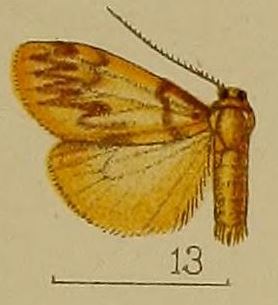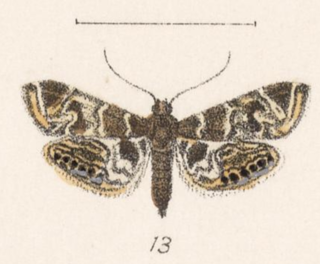
Francis Walker was an English entomologist. He was born in Southgate, London, on 31 July 1809 and died at Wanstead, England on 5 October 1874. He was one of the most prolific authors in entomology, and stirred controversy during his later life as his publications resulted in a huge number of junior synonyms. However, his assiduous work on the collections of the British Museum had great significance.
Dipaenae is a genus of moths in the subfamily Arctiinae. The genus was erected by Francis Walker in 1854.
Dotha is a genus of moths in the subfamily Arctiinae. It contains the single species Dotha ctenuchoides, which is found in Sumatra.

Collomeninae is a subfamily of the moth family Nolidae. The subfamily was erected by Reza Zahiri, J. Donald Lafontaine and B. Christian Schmidt in 2012.
Lysceia is a monotypic moth genus in the subfamily Arctiinae described by Francis Walker in 1854. It contains a single species, Lysceia bigutta, described by the same author in the same book, which is found in South Africa.

Neasura is a genus of moths in the subfamily Arctiinae. The genus was first described by George Hampson in 1900.

Secusio is a genus of moths in the subfamily Arctiinae first described by Francis Walker in 1854.
Olulis is a genus in the moth family Erebidae. There are about eight described species in Olulis, found in South, Southeast, and East Asia, and in Australia.

Tephriopis is a monotypic moth genus of the family Erebidae. Its only species, Tephriopis divulsa, was first described by Francis Walker in 1865.
Argidava is a genus of moths in the family Geometridae erected by Francis Walker in 1863.

Usingeriessa onyxalis is a moth of the family Crambidae. It is native to southern Texas, Mexico and Central America. It is an introduced species in Hawaii.
Amerila rhodopa is a moth of the subfamily Arctiinae. It was described by Francis Walker in 1865. It is found in India.
Helcystogramma immeritellum is a moth in the family Gelechiidae. It was described by Francis Walker in 1864. It is known from Java in Indonesia and from Sri Lanka.

Dipaenae contenta is a moth of the subfamily Arctiinae first described by Francis Walker in 1854. It is found in the Amazon region.
Hyda basilutea is a moth of the subfamily Arctiinae. It was described by Francis Walker in 1854. It is found in Costa Rica, Colombia, Venezuela and Brazil.

Macrobrochis gigas is a moth of the family Erebidae. It was described by Francis Walker in 1854. It is found in China (Yunnan), India (Sikkim), Bhutan, Nepal, Indonesia, Thailand, Hong Kong and Taiwan. The habitat consists of woodlands.
Opharus corticea is a moth of the family Erebidae. It was described by Francis Walker in 1856. It is found in Venezuela.

Eudulophasia invaria is a species of moth in the family Geometridae first described by Francis Walker in 1854.

Proteuxoa comma is a species of moth in the family Noctuidae. It is endemic to New Zealand. It can be found in the lower half of the North Island and throughout the South Island, although it appears to be more frequent on the eastern side of these islands, and also is present in Stewart Island. P. comma is very similar in appearance to P. tetronycha but can be distinguished as it is a larger moth with slightly different colouration on, as well as shape of, its forewings. This species pupates in the soil. The adult moths are on the wing from December to April. P. comma may possibly be declining in population and as at 2017 a reassessment of its conservation status is regarded as being needed.

Ammatho cuneonotatus, the footman moth, is a moth of the subfamily Arctiinae. The species was first described by Francis Walker in 1855. It is found in Cambodia, China, Nepal, Thailand, Peninsular Malaysia and Sumatra.










